With even compacts like the Chevrolet Cavalier Cobalt Cruze, Ford Focus, and Honda Civic getting too large (or at least too heavy) for my taste, I was pleased when more manufacturers added smaller, "B-segment" cars to their North American lineups. We can now choose among the Ford Fiesta, Honda Fit, Hyundai Accent, Kia Rio, Mazda2, Nissan Versa, Toyota Yaris, and Chevrolet Aveo Sonic. Sadly, few were tuned to provide much beyond basic transportation. A firm believer that "it's more fun to drive a slow car fast than a fast car slow," I'm generally the last enthusiast to feel a car needs more power. But most of these need, if not more power (and more power would help), more spirit, an eagerness to respond instantly and precisely (if not strongly) to the slightest input.
When equipped with its optional 138-horsepower turbocharged 1.4-liter engine, six-speed manual transmission, and low-profile 17-inch tires, the 2012 Chevrolet Sonic was arguably the most fun-to-drive in the B-segment bunch. (I enjoyed driving a mid-level Sonic with the standard 1.8, automatic transmission, and 15-inch wheels far less.) For 2013, Chevrolet has turned up the wick with a Sonic RS variant. To create the RS, Chevrolet lowered the suspension a half-inch, finessed the springs and dampers, replaced the rear drum brakes with discs, fitted more supportive front seats, and added some sporty styling bits. Welcome changes, but are they enough to warrant serious consideration by driving enthusiasts ISO something petite?
At present, no B-segment car packs more power than the Sonic RS, and only the Hyundai/Kia sibs manage to tie it. You can only get a manual transmission in an unoptioned, grip-challenged Rio, so the more enthusiast-oriented Accent SE wins the challenger spot.
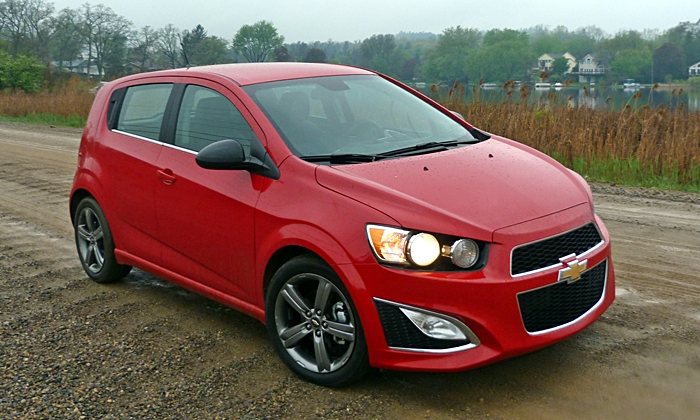
Staggered quad round headlights an interesting detail. more Sonic photos
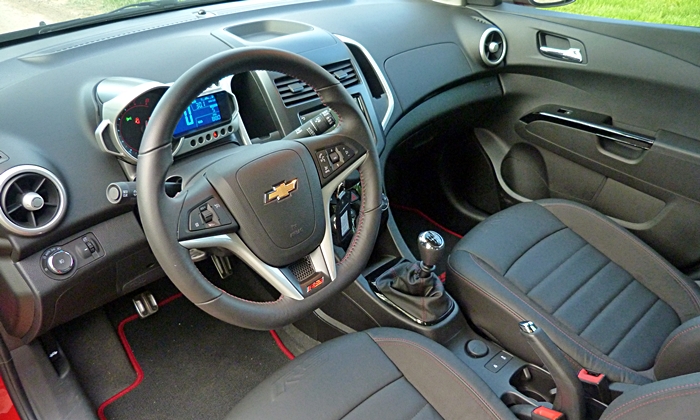
Flat-bottomed steering wheel, metal pedals, red stitching help make the inside of the RS special.
| |
Compared to the Accent |
| Ride smoothness |
 Better
Worse
Better
Worse
|
If Chevrolet had turned the wick way up to create the Sonic RS, then you'd be reading about handling right now. Maybe even powertrain performance. But the engine hasn't changed at all, and the suspension hasn't changed much.
This lack of substantial change has a good side. Even in RS form the Sonic rides smoothly and quietly compared to other small hatchbacks. Have a long commute over poorly maintained highways? No problem. The Ford Fiesta does about as well in this regard. The Hyundai Accent, though still not what I'd call noisy or rough, is much more likely to make you wish you were driving something larger and cushier.
| Feature availability |
 Better
Worse
Better
Worse
|
Hyundai lets you get a manual transmission in a small car with some basic luxuries (please pardon the oxymoron): alloy wheels, Bluetooth, a leather-wrapped steering wheel. But if you want a sunroof you must also get an automatic transmission. And if you want leather upholstery with sueded microfiber inserts and red stitching, heated seats, or simply a telescoping steering wheel, then the Accent is off your consideration list. But the Sonic isn't. All of these features, plus digital instrumentation, a sophisticated phone-based infotainment system, and four additional airbags, are standard on the RS. (New options for 2014 include a rearview camera, forward collision warning, and lane departure warning.) In the B-segment, only the Ford Fiesta and MINI Cooper (the latter not a direct competitor) are available with as many features. Unless you want the upcoming high-performance Fiesta ST with an automatic transmission. Unlike the Sonic RS, it won't be available with one.
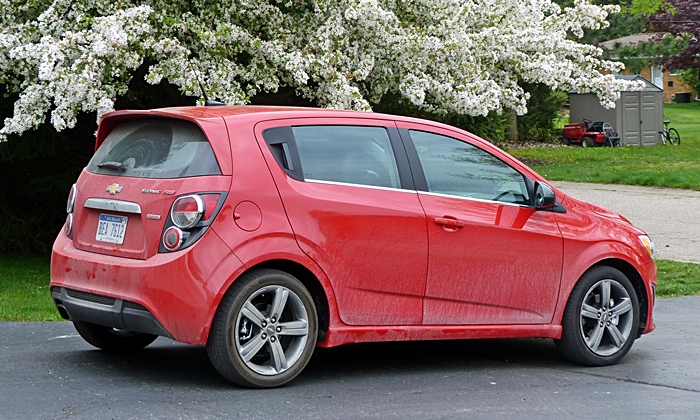
Truncated tail looks better from an angle. Dirt saves retinas from bright red paint.
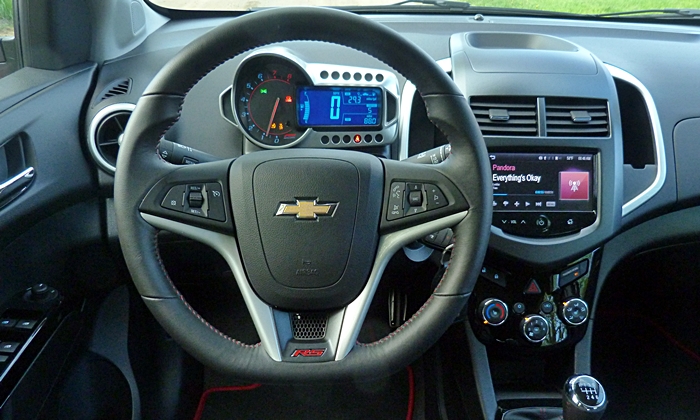
Everything is close at hand, but a pair of knobs for the audio system would be welcome.
| Handling |
 Better
Worse
Better
Worse
|
Now that we've given the Chevrolet Sonic credit for its big-car (or at least bigger-car) ride and big-car feature set, we can talk about handling. Standing just under 60 inches (vs. the Hyundai's much more typical 57), the Sonic is nearly tall enough to be considered a crossover. You sit high, with a deep instrument panel between you and a distant windshield. With a curb weight of 2,811 pounds, the Sonic RS is also nearly 400 pounds heavier than the Hyundai. Given this driving position and curb weight, it shouldn't suprise that the Sonic doesn't feel small and light from the driver's seat.
This isn't to say that the Sonic RS handles badly. Aided by the RS-specific tweaks, it handles with admirable precision, a moderate amount of lean, and excellent composure. The Accent, though also a compentent handler, feels rougher around the edges and not as dialed-in. The Sonic's steering doesn't feel quick or chatty, but it weights up naturally when turned and communicates better than most (e.g. the Accent's much more artificial-feeling tiller). Need a small car to tackle a challenging road with confidence? Done. Even if you turn the stability control off you'd be hard-pressed to get in over your head. The Hankook Optimo tires (same as on the Sonic LTZ) aren't the grippiest, but they hold up reasonably well under duress and give way progressively (outside front first) without raising too much of a fuss.
In sum, the Sonic RS handles competently, even enjoyably, especially compared to other B-segment hatches. But it doesn't possess the tossable character I personally crave in a car.
| Powertrain performance |
 Better
Worse
Better
Worse
|
The character of the Sonic RS's powertrain, unchanged aside from shorter gearing, suits that of its chassis. Long on competence, a bit short on thrills. Boosted by a turbocharger, the small four-cylinder engine possesses the plump midrange so clearly absent from all current competitors, including the Hyundai. For accessible grunt, nothing else in the segment comes close. Peak torque, 148 pound-feet, arrives at just 2,500 rpm (and at 1,850 with the automatic) vs. 123 at 4,850 in the Hyundai. But if you enjoy winding an engine out, well, there's no point in the Sonic. It's not that kind of engine. Owing to the tiny, lag-reducing size of the turbo, the 1.4 runs out of breath early, peaking at just 4,900 rpm (vs. 6,300 with the Accent's 1.6). A shame, as the shifter is more pleasant to operate than the crunchy, balky unit in the Hyundai.
Ford is taking a different approach with the upcoming 2014 Fiesta ST, which will be powered by a 197-horsepower turbocharged 1.6-liter engine. Both Chevrolet and Hyundai have similar engines in their arsenals. If the Fiesta ST sells well, perhaps they'll offer these engines in the Sonic and Accent.
| Interior styling |
 Better
Worse
Better
Worse
|
Like that in every other car in the segment, the Chevrolet Sonic's interior is chock full of hard plastic surfaces that make little effort to disguise their composition. Designers might praise this "material honesty," but no one will find the result cosseting or beautiful.
Yet here we are in the "why to buys." Why? Well, with the sport bike-inspired instrument cluster and circular outboard air vents found in all Sonics plus the red stitching, flat-bottomed steering wheel, fancy seats, and metal pedals unique to the RS, this Sonic's interior looks and feels special--and fun. Others in the segment, including that in the Accent, do not.
| |
Compared to the Accent |
| Exterior styling |
 Better
Worse
Better
Worse
|
A similar argument might be made for the Sonic RS's exterior. But I can't quite make it, and other exteriors in the segment are more stylish, so this one's in the "why nots." Chevrolet deserves credit for not playing it safe with the Sonic's styling. Up front, staggered quad round headlights flank a huge, Audiesque grille. These sweep through the front fenders into a tall, chunky body which ends abruptly once past the rear wheels. Intriguing, perhaps even striking. But not pretty. There's no good defense for the vast expanse of black plastic around the hidden (from my ten-year-old at least) rear door handle. The RS-specific body kit and gray wheels kick the look up a notch without making it out of bounds for anyone over 25.The Accent's exterior, though also on the busy side, poses less of a challenge to conventional aesthetics.
| Driving position & visibility |
 Better
Worse
Better
Worse
|
You sit high in the Sonic RS, but with a distant windshield, high beltline (base of the windows), and thick pillars you can't see out well. The view forward is a bit better in the Hyundai, but its rear window is barely there (and no rearview camera is available to compensate).
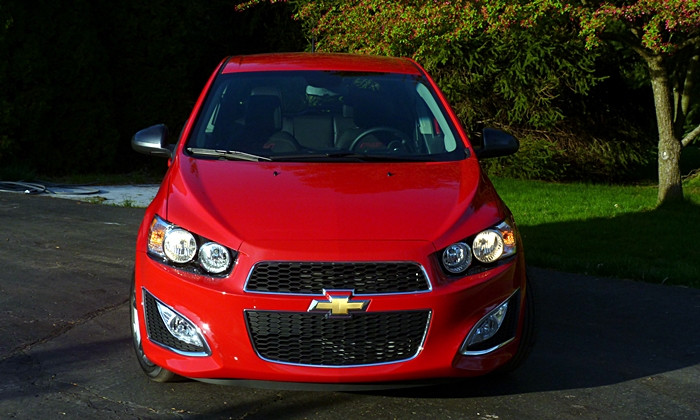
My, what a big grille you have!
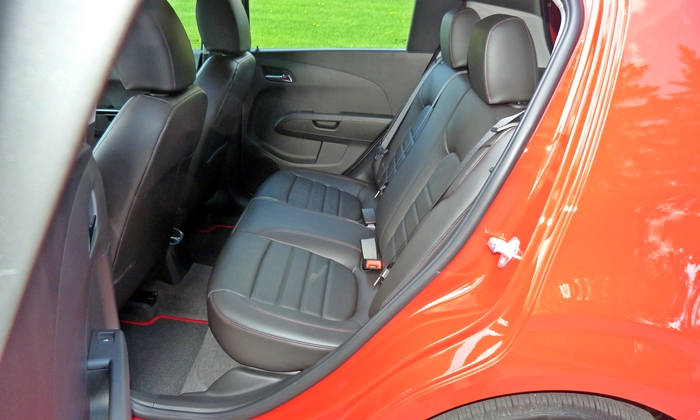
Adults will fit with little room to spare. Typical of the segment.
| Controls and instruments |
 Better
Worse
Better
Worse
|
The standard MyLink infotainment system will appeal to technophiles on a budget. This system provides support for phone-based apps, operated via a touchscreen. Support for Pandora and Stitcher is standard, while navigation is a $50 option. But this system is not without some weaknesses. First, the infotainment system is knob-free. All audio functions aside from volume and source (on the steering wheel) must be managed via the touchscreen. I don't enjoy channel surfing via touchscreen. Second, you can't access more than one app at a time, so it's either nav or Internet-based radio, not both at once. And switching between them proved difficult. Lastly, the nav is fairly basic (though it does include traffic alerts) and could be easier to use. But, hey, how much do you expect for fifty bucks? You can't display nav in any form on the Accent's instrument panel.
| |
Compared to the Accent |
| Fuel economy |
 Better
Worse
Better
Worse
|
The regular Chevrolet Sonic with the 1.4T engine and 6-speed manual manages 29 mpg city, 40 mpg highway in the EPA's tests, about as good as you'll find in a car with a conventional powertrain. The Sonic RS owing to its shorter gearing scores much lower, 27/34. But much of the difference appears to follow from not gaming the tests. In my 70 mile-per-hour highway driving the trip computer reported a 41 mpg average. It reported about the same if I drove with an especially light foot in the suburbs. When I moved at the typical speed of traffic, the suburban average dropped to about 35. Push the car hard, and this average can drop as low as 25. Based on its trip computer in my driving, the Accent (EPA 28/37) might squeeze one or two more miles from each gallon. Given the innaccuracies of trip computers, they're well within the same ballpark. Despite its much more powerful engine, the Fiesta ST should be nearly as fuel efficient, with EPA ratings of 26/35.
| Front seat support & comfort |
 Better
Worse
Better
Worse
|
The RS-specific front seats look comfortable, and for most people should feel as comfortable as they look. For some of us, though, the headrests just too far forward. And enthusiasts will wish Chevrolet had more aggressively enhanced the side bolsters. (Ford will offer much more supportive seats in the Fiesta ST.)
| Rear seat room & comfort |
 Better
Worse
Better
Worse
|
You can fit a couple of average-sized adults in the Sonic's rear seat, at least for short distances. Headroom abounds. Knee room does not. The Accent's rear seat is a smidge tighter. Anyone scrunched into the back of a Ford Fiesta (especially one with the ST's huge optional Recaro front seats) will wish it was just a smidge tighter.
| Cargo capacity |
 Better
Worse
Better
Worse
|
If we're being charitable, the Sonic's truncated tail lends visual interest. But it does no favors for cargo capacity. The Sonic roughly ties the Accent in its official cargo specs (19 cubic feet with the seat up, 48 cubic feet with it folded), but only because of its higher roof. As with other cars in this segment, there's easily enough cargo capacity for the typical weekly shopping trip. But for hauling large items you'll need a larger car.
One annoyance: to fold the rear seat you'll likely have to move the front seats forward (then back again once it's down). The front passenger seat cannot fold flat to extend the cargo area, but competitors don't offer this feature, either.
| Price or payments |
 Better
Worse
Better
Worse
|
With nearly everything standard, the Chevrolet Sonic RS has the highest base price in the segment (for 2013): $20,995. The previously top-of-the-line LTZ 1.4T starts much lower, $19,360. Adjust for the RS's additional features (disc brakes, body kit, leather seats, metal pedals), and they're only about $100 apart. So the price bump is fair. The Hyundai Accent SE with floormats lists for $16,985--a substantial $4,000 less than a Sonic RS--but as noted above includes far fewer features. Adjust for these and the gap drops to about $800. Those who prefer how the Sonic looks and drives should be able to justify this premium. Don't want all of the RS equipment? The LT has a feature set and price close to those of the Accent.
The upcoming Ford Fiesta ST could pose a much tougher challenge. Though a much higher-performance machine, it will start only $1,045 higher than a 2014 Sonic RS. Adjust for the Sonic's additional standard features, and the difference will clear $2,300, but even this seems too close for Chevrolet's comfort. Want heated leather seats? Then the Fiesta ST will cost $3,000 more before adjusting for feature differences, and nearly $3,600 more afterwards. Now we're starting to talk about real money.
Compared to its 2013 competitors, including the Hyundai Accent, the Chevrolet Sonic RS looks more special, offers more features, packs more mid-range grunt, and drives with greater precision and composure. It might not be a great car, but it's a very good one, and I enjoyed my time in it.
Still, I'm a little disappointed that the Chevrolet Sonic RS isn't the tossable pocket rocket that the 2014 Ford Fiesta ST promises to be. Chevrolet should consider injecting some meth into the Sonic's steering and offering the 202-horsepower 1.6-liter turbocharged engine from the Opel Corsa VXR Nurburgring. Would such a Sonic no longer befit the RS badge, and warrant an upgrade to SS status? Do it right, and they'd have no argument from me.
But such a car would cost significantly more than the RS, as the Fiesta ST will if you similarly spec it with heated leather seats. Some people might not feel the need for 200 horsepower in a small hatch. Or the Sonic RS might already be at the upper limit of what they can afford. For these people, the Sonic RS could hit the sweet spot.
Is this too small a target for the Sonic RS to succeed? Perhaps. To sneak the starting price under the critical $20,000 mark, Chevrolet could make the heated hides an option. I wouldn't be surprised to see this happen if the Fiesta ST proves too close for comfort.
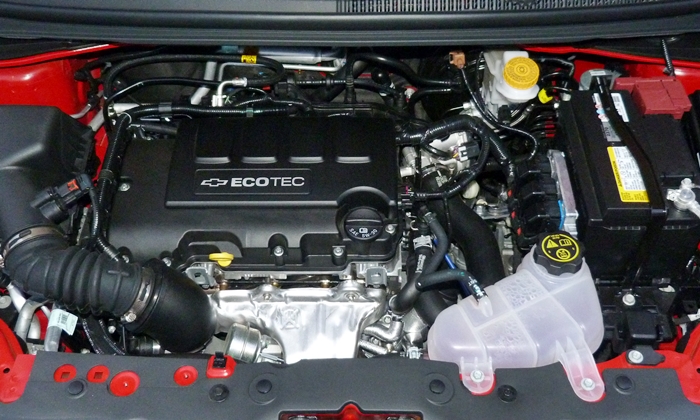
RS gets 138hp 1.4T engine optional in regular Sonic. Good mid-range, but runs out of breath.
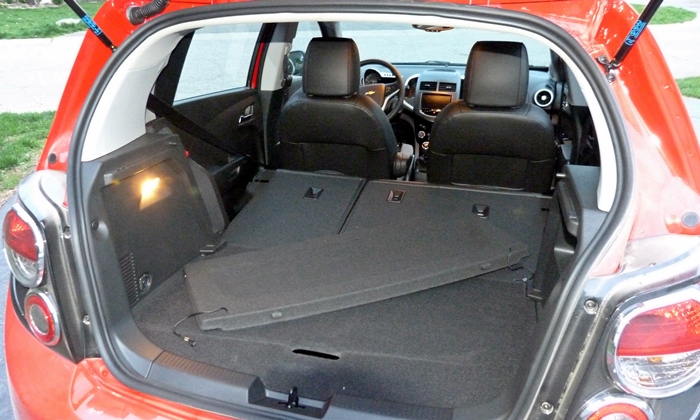
No magic seat plus truncated tail mean cargo volume is, like the rear seat, typical of the segment.
See more 2013 Chevrolet Sonic photos
Chevrolet and Hyundai each provided insured cars for a week with a tank of gas.











